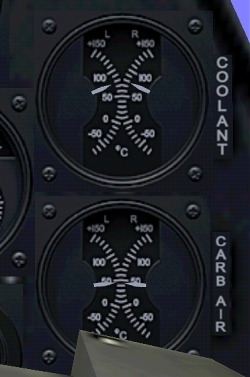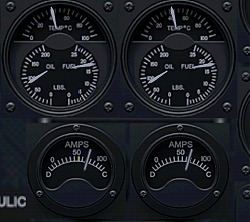|
Starting Checklist for B17 F/G
|
||||
|
Check Fire Guard Check Fire Guard and Call "Clear." Look out the window and be sure that the fire guard is posted at his proper station- behind and to the right of the engine being started. The starting sequence is engines No.1, No.2, No.3, and No.4. This sequence should be followed each time in order to avoid confusion for the ground crew. The pilot calls "Clear left, and the copilot calls "Clear right," before engines are started on either side. Both will make sure that the mechanic hears the call, and signifies (by voice or hand signal) that all is clear. Master and Ignition Switches Place the bar switch in the "ON" position. Put all ignition switches in "BOTH" position. (NOTE: Except in the B-17G where individual ignition switches are turned "ON" after hte corresonding engine is meshed and the propeller has turned through one revolution.) Battery Switches and Inverter Move the inverter switch to "NORMAL." Then operate each battery switch separately to detect a battery in need of charging. Check the fuse and solenoid. Return all three battery switches to "ON." Now check inverter in "ALTERNATE" position. REturn the inverter switch to "NORMAL," and leave it there during flight. The alternate inverter is used only in the event that the normal inverter fails. The alternate remains new and unused for such an emergency. Parking Brakes and Hydraulic Check Copilot sets and locks the parking brakes. Check the pressure guages for sufficient hydraulic pressure (600-800 lb.). Check the switch on the pilot's switch panel for the "AUTO" or "ON" position- depending on the type of switch installed. If the emergency pressure system is low, recharge by opening the manual shut-off (star) valve. This will build up pressure in both systems to approximately 800 lb. After recharging, close the manual shut-off (star) valve. If emergency system is installed, operate levers to ensure that upon application pressure does not drop immediately to zero. Be sure that the selector is in "NORMAL" position, and that the reservoir is filled with hydraulic fluid. |
Booster Pumps Turn on the boosster pumps and check to see that each gives from 6 to 8 lb. pressure. The fuel booster pump is an independent electrically driven source of extra fuel pressure. It takes the place of the wobble pump for both starting and emergencies, and augments the engine-driven fuel pump at high altitudes. As a safety measure, it is always turned on for takeoff and landing, for flights below 1000 feet, and for flights above 10,000 feet.  Carburetor Filters Carburetor air filters must be "ON" ("OPEN") for engine starting and all operations up to 8,000 feet in the B-17F (15,000 feet in the B-17G). Check amber warning light for "ON." In dust conditions filters may be left "ON" in the B-17F up to 15,000 feet (20,000 feet in tehe B-17G.) But under no circumstances should the carburetor air filters be left "ON" above these limits. When intake air passes throught he carburetor air filters at such altitude the turbo-superchargers must speed up to maintain desired manifold pressure. This can result in turbo overspeeding.  Fuel Quantity Check the fuel guages for quantity of fuel in each tank. Remember that the fuel guages are electric and will not operate unless the battery switches and inverter are "ON." Go to Part II: START ENGINES
|
|||
|
Copyright © 1997 - 2000 COMBATSIM.COM, INC. All Rights Reserved. Last Updated August 10th, 1999 |
||||
